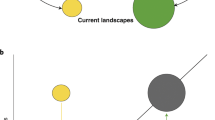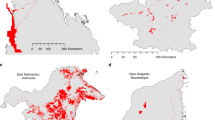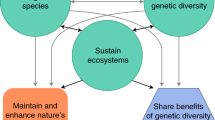Abstract
One proposal for the Convention on Biological Diversity’s post-2020 strategic plan is ‘zero loss’ of natural habitats. However, the feasibility of zero loss was questioned during the Trondheim Conference for Biodiversity, and it was suggested that biodiversity losses are instead balanced by compensatory efforts (that is, ‘no net loss’). The focus on net outcomes is echoed by separate calls for a global mitigation hierarchy to deliver no net biodiversity loss and accommodate both conservation and development goals. Here we show that ‘no net loss’ is not the same as ‘zero loss’. We use a delayed differential model of nonlinear habitat dynamics to demonstrate how applying the mitigation hierarchy for net biodiversity outcomes will lead to biodiversity declines by midcentury. Delayed compensation of human impacts reduces ecological resilience and causes prolonged biodiversity losses. These effects are greatest when impacts are large and compensation delays are long. Our results support the use of fixed targets, rather than net outcomes, as part of the post-2020 biodiversity framework.
This is a preview of subscription content, access via your institution
Access options
Access Nature and 54 other Nature Portfolio journals
Get Nature+, our best-value online-access subscription
$29.99 / 30 days
cancel any time
Subscribe to this journal
Receive 12 digital issues and online access to articles
$119.00 per year
only $9.92 per issue
Buy this article
- Purchase on Springer Link
- Instant access to full article PDF
Prices may be subject to local taxes which are calculated during checkout



Similar content being viewed by others
Data availability
Simulation outputs are available at: https://doi.org/10.6084/m9.figshare.11841906.
Code availability
All R scripts are available at https://doi.org/10.6084/m9.figshare.11841906.
References
Mace, G. M. et al. Aiming higher to bend the curve of biodiversity loss. Nat. Sustain. 1, 448–451 (2018).
Making Biodiversity Matter. Knowledge and Know-how for the post-2020 Global Biodiversity Framework. Report to the Co-chairs. The Ninth Trondheim Conference on Biodiversity (Trondheim Conferences on Biodiversity, 2019).
Open-ended Working Group on the post-2020 Global Biodiversity Framework Zero Draft of the post-2020 Global Biodiversity Framework CBD/WG2020/2/3 (Convention on Biological Diversity, 2020).
Arlidge, W. N. S. et al. A global mitigation hierarchy for nature conservation. BioScience 68, 336–347 (2018).
Addison, P. F. E. & Bull, J. W. Conservation accord: corporate incentives. Science 360, 1195–1196 (2018).
Bull, J. W. et al. Net positive outcomes for nature. Nat. Ecol. Evol. 4, 4–7 (2020).
Gibbons, P., Macintosh, A., Constable, A. L. & Hayashi, K. Outcomes from 10 years of biodiversity offsetting. Glob. Change Biol. 24, e643–e654 (2018).
zu Ermgassen, S. O. S. E. et al. The ecological outcomes of biodiversity offsets under ‘no net loss’ policies: a global review. Conserv. Lett. 12, e12664 (2019).
Beisner, B. E., Haydon, D. T. & Cuddington, K. Alternative stable states in ecology. Front. Ecol. Environ. 1, 376–382 (2003).
Ghazoul, J. & Chazdon, R. Degradation and recovery in changing forest landscapes: a multiscale conceptual framework. Annu. Rev. Environ. Resour. 42, 161–188 (2017).
van de Leemput, I. A., Dakos, V., Scheffer, M. & van Nes, E. H. Slow recovery from local disturbances as an indicator for loss of ecosystem resilience. Ecosystems 21, 141–152 (2018).
Scheffer, M. et al. Catastrophic shifts in ecosystems. Nature 413, 591–596 (2001).
Sato, C. F. & Lindenmayer, D. B. Meeting the global ecosystem collapse challenge. Conserv. Lett. 11, e12348 (2018).
Barnosky, A. D. et al. Approaching a state shift in Earth’s biosphere. Nature 486, 52–58 (2012).
Hodgson, D., McDonald, J. L. & Hosken, D. J. What do you mean, ‘resilient’? Trends Ecol. Evol. 30, 503–506 (2015).
Ingrisch, J. & Bahn, M. Towards a comparable quantification of resilience. Trends Ecol. Evol. 33, 251–259 (2018).
Meyer, K. et al. Quantifying resilience to recurrent ecosystem disturbances using flow–kick dynamics. Nat. Sustain. 1, 671–678 (2018).
Ghazoul, J., Burivalova, Z., Garcia-Ulloa, J. & King, L. Conceptualizing forest degradation. Trends Ecol. Evol. 30, 622–632 (2015).
Maron, M. et al. Faustian bargains? Restoration realities in the context of biodiversity offset policies. Biol. Conserv. 155, 141–148 (2012).
Curran, M., Hellweg, S. & Beck, J. Is there any empirical support for biodiversity offset policy? Ecol. Appl. 24, 617–632 (2014).
Bull, J. W., Gordon, A., Watson, J. E. M. & Maron, M. Seeking convergence on the key concepts in ‘no net loss’ policy. J. Appl. Ecol. 53, 1686–1693 (2016).
Gonçalves, B., Marques, A., Soares, A. M. V. D. M. & Pereira, H. M. Biodiversity offsets: from current challenges to harmonized metrics.Curr. Opin. Environ. Sustain. 14, 61–67 (2015).
Schlesinger, W. H. et al. Biological feedbacks in global desertification. Science 277, 1043–1048 (1990).
Janssen, R. H. H., Meinders, M. B. J., van Nes, E. H. & Scheffer, M. Microscale vegetation-soil feedback boosts hysteresis in a regional vegetation-climate system. Global Change Biol. 14, 1104–1112 (2008).
Maron et al. Locking in loss: baselines of decline in Australian biodiversity offset policies. Biol. Conserv. 192, 504–512 (2015).
Maron, M. et al. Conservation: stop misuse of biodiversity offsets. Nature 523, 401–403 (2015).
Simmonds, J. S. et al. Moving from biodiversity offsets to a target-based approach for ecological compensation. Conserv. Lett. https://doi.org/10.1111/conl.12695 (2019).
Wu, P. P. et al. Timing anthropogenic stressors to mitigate their impact on marine ecosystem resilience. Nat. Commun. 8, 1263 (2017).
Moilanen, A. & Laitila, J. Indirect leakage leads to a failure of avoided loss biodiversity offsetting. J. Appl. Ecol. 53, 106–111 (2016).
Buschke, F. T. Biodiversity trajectories and the time needed to achieve no net loss through averted-loss biodiversity offsets. Ecol. Model. 352, 54–57 (2017).
Gibbons, P. et al. A loss‐gain calculator for biodiversity offsets and the circumstances in which no net loss is feasible. Conserv. Lett. 9, 252–259 (2016).
Bull, J. W., Lloyd, S. P. & Strange, N. Implementation gap between theory and practice of biodiversity offset multipliers. Conserv. Lett. 10, 656–669 (2017).
Rossberg, A. On the mathematics of sustainability. Nat. Sustain. 1, 615–616 (2018).
Chapin-Kramer, R. et al. Spatial patterns of agricultural expansion determine effects on biodiversity and carbon storage. Proc. Natl Acad. Sci. USA 112, 7402–7407 (2015).
Fahrig, L. Ecological responses to habitat fragmentation per se. Annu. Rev. Ecol. Evol. Syst. 48, 1–23 (2017).
Gordon, A. Assessing the impacts of biodiversity offset policies. Environ. Modell. Softw. 26, 1481–1488 (2011).
Buschke, F. T. & Sinclair, S. P. Adding ecological and evolutionary processes to restoration biodiversity offset models using neutral theory. Divers. Distrib. 25, 1351–1361 (2019).
O’Brien, S. H., Cook, A. S. C. P. & Robinson, R. A. Implicit assumptions underlying simple harvest models of marine bird populations can mislead environmental management decisions. J. Environ. Manag. 201, 163–171 (2017).
Fagan, W. F. & Holmes, E. E. Quantifying the extinction vortex. Ecol. Lett. 9, 5–60 (2006).
Clark, T. J. & Luis, A. D. Nonlinear population dynamics are ubiquitous in animals. Nat. Ecol. Evol. 4, 75–81 (2020).
Maron, M., Simmonds, J. S. & Watson, J. E. M. Bold nature retention targets are essential for the global environment agenda. Nat. Ecol. Evol. 2, 1194–1195 (2018).
Henderson, K. A., Bauch, C. T. & Anand, M. Alternative stable states and the sustainability of forests, grasslands, and agriculture. Proc. Natl Acad. Sci. USA 113, 14552–14559 (2016).
Maron, M. et al. The many meanings of no net loss in environmental policy. Nat. Sustain. 1, 19–27 (2018).
R Core Team R: A Language and Environment for Statistical Computing (R Foundation for Statistical Computing, 2019).
Acknowledgements
We thank M. Maron and J. Bull for their comments.
Author information
Authors and Affiliations
Contributions
F.B. designed the study and ran the simulations, with input from S.B. Both authors wrote the manuscript.
Corresponding author
Ethics declarations
Competing interests
The authors declare no competing interests
Additional information
Publisher’s note Springer Nature remains neutral with regard to jurisdictional claims in published maps and institutional affiliations.
Supplementary information
Supplementary Information
Supplementary Section 1: Nonlinear dynamics of delayed mitigation for a population with a carrying capacity and Allee effects. Supplementary Section 2: Choice of values and sensitivity analysis for free parameters in the time-delayed mitigation model.
Rights and permissions
About this article
Cite this article
Buschke, F., Brownlie, S. Reduced ecological resilience jeopardizes zero loss of biodiversity using the mitigation hierarchy. Nat Ecol Evol 4, 815–819 (2020). https://doi.org/10.1038/s41559-020-1177-7
Received:
Accepted:
Published:
Issue Date:
DOI: https://doi.org/10.1038/s41559-020-1177-7
This article is cited by
-
Global conservation priorities for wetlands and setting post-2025 targets
Communications Earth & Environment (2024)



